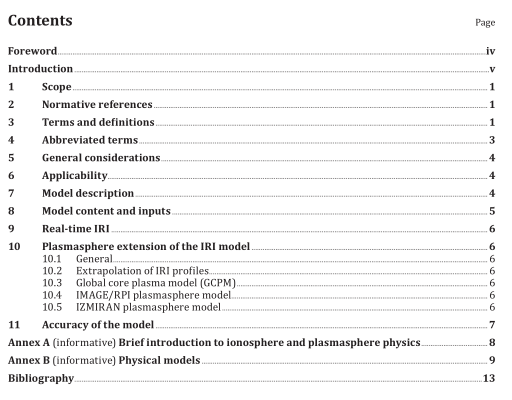ISO 16457 pdf download

ISO 16457 pdf download Space environment (natural and artificial) — The Earth’s ionosphere model — International reference ionosphere (IRI) model and extensions to the plasmasphere
1 Scope
This document provides guidance to potential users for the specification of the global distribution ofionosphere densities and temperatures, as well as the total content of electrons in the height intervalfrom 50 km to 1 500 km.It includes and explains several options for a plasmaspheric extension of themodel, embracing the geographical area between latitudes of 80’s and 80°N and longitudes of 0°E to360°E, for any time of day, any day of year, and various solar and magnetic activity conditions.
A brief introduction to ionospheric and plasmaspheric physics is given in Annex A.Annex B providesan overview over physical models, because they are important for understanding and modelling thephysical processes that produce the ionospheric plasma.
2Normative references
There are no normative references in this document.
3 Terms and definitions
For the purposes of this document, the following terms and definitions apply.
ISO and lEC maintain terminology databases for use in standardization at the following addresses:- ISo online browsing platform: available at https://www.iso.org/obp
—IEC Electropedia: available at https://www.electropedia.org/
3.1
ionosphere
region of the Earth’s atmosphere in the height interval from 50 km to 1 500 km containing weaklyionized cold plasma
3.2
plasmasphere
torus of cold, relatively dense (> 10 cm-3) plasma of mostly H+ in the inner magnetosphere, which istrapped on the Earth’s magnetic field lines and co-rotates with the Earth
Note 1 to entry: Cold plasma is considered to have an energy of between a few electronvolts and a few dozenelectronvolts.
3.3
plasmapause
outward boundary of the plasmasphere (3.2) located at between two and six Earth radii from the centreof the Earth and formed by geomagnetic field lines where the plasma density drops by a factor of 10 ormore across a range of L-shells of as little as 0,1
Note 1 to entry:The L-shell is a parameter describing a particular set of planetary magnetic field lines, oftendescribing the set of magnetic field lines which cross the Earth’s magnetic equator at a number of Earth-radiiequal to the L-value, e.g.”L = 2″ describes the set of the Earth’s magnetic field lines which cross the Earth’smagnetic equator two Earth radii from the centre of the Earth.
3.4
solar activity
series of processes occurring in the Sun’s atmosphere which affect the interplanetary space and theEarth
Note 1 to entry: The level of solar activity is characterized by indices.3.5
ionospheric storm
storm lasting about a day, documented by depressions and/or enhancements of the ionospheric electrondensity during various phases of the storm
Note 1 to entry: lonospheric storms are the ultimate result of solar flares or coronal mass ejections, whichproduce large variations in the particle and electromagnetic radiation that hit Earth’s magnetosphere andionosphere(3.1), as well as large-scale changes in the global neutral wind, composition and temperature.
3.6
sunspot numberR
daily index of sunspot activity defined as k(10 g + s) where s is the number of individual spots,g is thenumber of sunspot groups, and k is an observatory factor
Note 1 to entry: R is alternatively called Ri or Rz or SSN.
Note 2 to entry:R12 is 12-month running mean of monthly sunspot number.
Note 3 to entry: In 2014 the calculation scheme for the officially distributed sunspot number was changed6i&Jwith the result that the new sunspot number [SSN2]) is about a factor of 1,45 larger than the old one(SSN1).
3.7
F10.7
solar radio flux at 10,7 cm wavelength measured at the ground daily at noon
Note 1 to entry: Besides this ‘observed’ F10.7 index there is also an ‘adjusted’F10.7 index that is adjusted to 1AU.often used averages are the 81-day (3 solar rotations) running mean and the 12-month running mean.
3.8
Lyman-a index
solar activity (3.4) index based on daily measured solar emission at 121,6 nm (H Lyman-a line)3.9
MGIl index
solar activity (3.4) index based on core-to-wing ratio of the magnesium ion h and k lines at 279,56 nmand 280,27 nm
3.10
Kp index
planetary three-hour index of geomagnetic activity characterizing the disturbance in the Earth’smagnetic field over three-hour universal time (UT) intervalsl87]
Note 1. to entry: The index scale is uneven quasi-logarithmic and assigned to successive 3 h UT intervals givingeight values per UT day,and ranges in 28 steps from 0(quiet) to 9 (disturbed).









